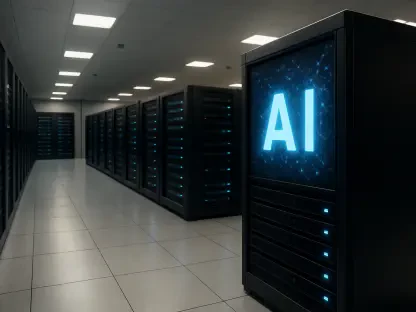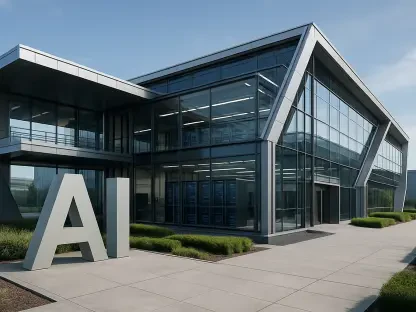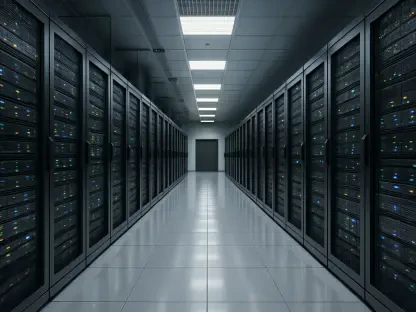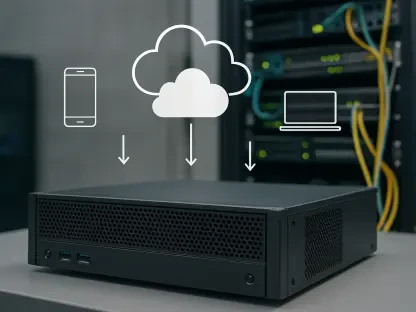In a world where artificial intelligence shapes everything from business to security, a hidden crisis brews in the heart of technology. Data centers, the unsung engines of the digital age, are consuming power at a scale that defies imagination—some campuses now rival small cities with demands reaching gigawatts. This staggering surge raises a critical question: can the infrastructure keep up with AI’s relentless hunger for energy, or will it buckle under the strain of this technological revolution?
The Unforeseen Power Surge
The rapid ascent of AI has caught the industry off guard, transforming data centers from modest power users into energy titans. A single facility can now require over a gigawatt of electricity, a leap from the megawatt scales of just a few years ago. This shift isn’t merely a technical footnote; it’s a fundamental challenge to how energy is sourced and managed on a global scale.
Beyond the raw numbers, this escalation signals a broader impact on resources. Grids designed for far smaller loads are being pushed to their limits, risking instability in regions unprepared for such demand. The urgency to adapt is palpable, as the digital economy hinges on these centers remaining operational without disruption.
This power surge also casts a spotlight on environmental concerns. With such massive energy needs, the carbon footprint of data centers is ballooning, prompting scrutiny from regulators and activists alike. Balancing technological progress with sustainability has become a pressing dilemma for the sector.
Why AI’s Energy Appetite Affects All
AI’s voracious need for power extends far beyond the confines of tech campuses, touching every corner of society. From powering global trade platforms to securing national defense systems, data centers are the backbone of critical operations, making their energy consumption a universal concern. The International Energy Agency projects that by 2026, these facilities could consume over 90 terawatt-hours of electricity annually—a figure that underscores the scale of the issue.
This energy demand influences economic stability as well. Rising power costs and potential shortages could ripple through industries, affecting everything from consumer prices to corporate budgets. Governments and businesses are now forced to rethink energy policies to prevent cascading effects on the broader economy.
Moreover, geopolitical tensions are emerging as nations vie for control over energy resources to fuel their AI ambitions. Data centers are no longer just infrastructure; they are strategic assets, amplifying the stakes for energy security. The implications of this trend resonate on a global stage, affecting international relations and policy decisions.
Redefining Infrastructure for the Gigawatt Era
The transition to gigawatt-scale data centers is rewriting the rules of design and operation in profound ways. Power loads are now up to six times larger than what traditional grids were built to handle, exposing vulnerabilities in existing systems. This necessitates a complete overhaul of how facilities are planned and integrated with utility networks to prevent widespread outages.
Innovative projects, such as Lancium’s Stargate campus in Texas, highlight the need for seamless grid coordination. These initiatives demonstrate that managing sudden load fluctuations is critical to maintaining regional stability. Without such integration, the risk of power disruptions looms large, threatening not just data centers but entire communities.
At the hardware level, the challenges are equally daunting. Rack power densities have soared from 270 kW to 480 kW per rack in a short span, rendering traditional air cooling ineffective. Solutions like liquid and hybrid cooling systems, including Dell’s rear-door heat exchangers, are slashing energy use by up to 30% in a 10 MW setup, proving essential for managing the heat of high-density computing.
Insights from Industry Pioneers
Voices from the forefront of this transformation paint a vivid picture of urgency and innovation. Michael McNamara of Lancium cautions that without adaptive power strategies like battery storage, “load trips could unleash chaos” across grids. His perspective emphasizes the need for dynamic solutions to balance reliability with escalating demands.
David Holmes of Dell Technologies points to the engineering hurdles at play, stating that “computational capacity is constrained even by the speed of light.” This insight drives the push for cutting-edge cooling and design innovations to keep pace with AI’s needs. Dell’s AI service sales, climbing to $12.1 billion in the first quarter of this year with a $14.1 billion backlog, reflect the intense market pressure fueling these advancements.
These expert opinions converge on a stark reality: conventional approaches to data center management are obsolete. The industry must pivot swiftly to new technologies and collaborative models to avoid being outpaced by AI’s exponential growth. Their warnings and solutions offer a roadmap for navigating this uncharted terrain.
Strategies for a Gigawatt-Ready Future
Addressing the challenges of AI-driven data centers requires practical, forward-thinking measures. Collaboration stands as a cornerstone—operators must partner with grid utilities, vendors, and developers to co-design facilities that can handle massive power swings. Real-time data sharing with energy providers can enhance stability and prevent catastrophic failures.
Investment in advanced cooling technologies is another vital step. Transitioning to direct liquid or hybrid systems offers a way to manage the intense heat of high-density racks efficiently. These innovations not only cut energy waste but also extend the lifespan of critical equipment under extreme conditions.
Finally, building flexibility into operations is non-negotiable. Incorporating battery storage systems helps mitigate power price spikes and ensures resource adequacy during peak demand. Such measures allow data centers to scale computing power without risking grid overloads, providing a buffer against the unpredictability of AI workloads.
Looking back, the journey of data centers from megawatt to gigawatt scales marked a defining chapter in technological history. As AI reshaped the digital landscape, it compelled the industry to confront its energy challenges head-on. Reflecting on those efforts, the path forward became clear: stakeholders had to prioritize innovation, deepen partnerships with energy sectors, and commit to sustainable practices. Only through such dedicated action could the balance between technological advancement and environmental responsibility be achieved, ensuring that the backbone of the digital age remained robust for generations to come.









